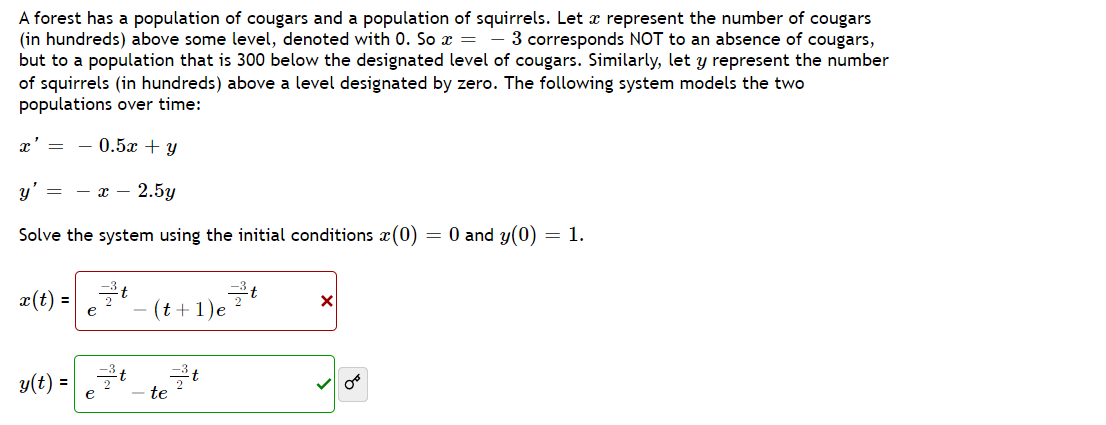A forest has a population of cougars and a population of squirrels. Let a represent the number of cougars (in hundreds) above some level, denoted with 0. So x = 3 corresponds NOT to an absence of cougars, but to a population that is 300 below the designated level of cougars. Similarly, let y represent the number of squirrels (in hundreds) above a level designated by zero. The following system models the two populations over time: x' = 0.5x + y y' - x 2.5y Solve the system using the initial conditions (0) = 0 and y(0) = 1. t t x(t) = X e (t+1) e y(t) = t e te
A forest has a population of cougars and a population of squirrels. Let a represent the number of cougars (in hundreds) above some level, denoted with 0. So x = 3 corresponds NOT to an absence of cougars, but to a population that is 300 below the designated level of cougars. Similarly, let y represent the number of squirrels (in hundreds) above a level designated by zero. The following system models the two populations over time: x' = 0.5x + y y' - x 2.5y Solve the system using the initial conditions (0) = 0 and y(0) = 1. t t x(t) = X e (t+1) e y(t) = t e te
Linear Algebra: A Modern Introduction
4th Edition
ISBN:9781285463247
Author:David Poole
Publisher:David Poole
Chapter4: Eigenvalues And Eigenvectors
Section4.6: Applications And The Perron-frobenius Theorem
Problem 66EQ
Related questions
Question
A forest has a population of cougars and a population of squirrels. Let xx represent the number of cougars (in hundreds) above some level, denoted with 0. So x=−3x=-3 corresponds NOT to an absence of cougars, but to a population that is 300 below the designated level of cougars. Similarly, let yy represent the number of squirrels (in hundreds) above a level designated by zero. The following system models the two populations over time:
x'=−0.5x+yx′=-0.5x+y
y'=−x−2.5yy′=-x-2.5y
Solve the system using the initial conditions x(0)=0x(0)=0 and y(0)=1y(0)=1.
x(t)x(t) = e−32t−(t+1)e−32tIncorrect
y(t)y(t) = e−32t−te−32tCorrect
Choose the graph that best represents the solution curve.

Transcribed Image Text:A forest has a population of cougars and a population of squirrels. Let a represent the number of cougars
(in hundreds) above some level, denoted with 0. So x = 3 corresponds NOT to an absence of cougars,
but to a population that is 300 below the designated level of cougars. Similarly, let y represent the number
of squirrels (in hundreds) above a level designated by zero. The following system models the two
populations over time:
- 0.5x + y
y’ = − x − 2.5g
Solve the system using the initial conditions (0) = 0 and y(0) = 1.
x(t) =
t
t
e
(t+1)e
y(t) = ²³t
t
e
OF
te
Expert Solution
This question has been solved!
Explore an expertly crafted, step-by-step solution for a thorough understanding of key concepts.
Step by step
Solved in 2 steps with 2 images

Recommended textbooks for you

Linear Algebra: A Modern Introduction
Algebra
ISBN:
9781285463247
Author:
David Poole
Publisher:
Cengage Learning

Algebra for College Students
Algebra
ISBN:
9781285195780
Author:
Jerome E. Kaufmann, Karen L. Schwitters
Publisher:
Cengage Learning

College Algebra
Algebra
ISBN:
9781305115545
Author:
James Stewart, Lothar Redlin, Saleem Watson
Publisher:
Cengage Learning

Linear Algebra: A Modern Introduction
Algebra
ISBN:
9781285463247
Author:
David Poole
Publisher:
Cengage Learning

Algebra for College Students
Algebra
ISBN:
9781285195780
Author:
Jerome E. Kaufmann, Karen L. Schwitters
Publisher:
Cengage Learning

College Algebra
Algebra
ISBN:
9781305115545
Author:
James Stewart, Lothar Redlin, Saleem Watson
Publisher:
Cengage Learning

Algebra and Trigonometry (MindTap Course List)
Algebra
ISBN:
9781305071742
Author:
James Stewart, Lothar Redlin, Saleem Watson
Publisher:
Cengage Learning

Elementary Linear Algebra (MindTap Course List)
Algebra
ISBN:
9781305658004
Author:
Ron Larson
Publisher:
Cengage Learning

Algebra: Structure And Method, Book 1
Algebra
ISBN:
9780395977224
Author:
Richard G. Brown, Mary P. Dolciani, Robert H. Sorgenfrey, William L. Cole
Publisher:
McDougal Littell